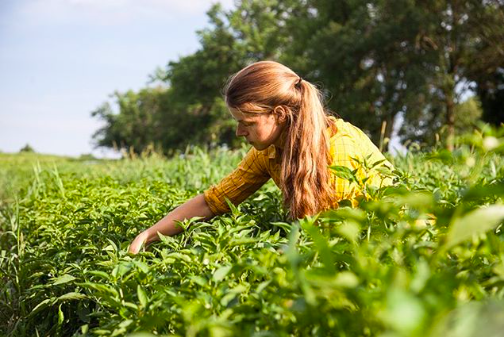
For farmers, periods of uncertainty are nothing new. Every year, they face the possibility of frosts, floods, droughts, and subsequent crop loss that can come with working at the whims of Mother Nature. Each spring is spent preparing as best they can for the busy months ahead, but this season, even the most veteran growers could not be ready for what would come next.
When the state’s first case of COVID-19 was confirmed on March 5, it would be just one week before Governor Hogan enacted social distancing measures to slow the coronavirus’s spread. In the coming days, many local businesses would close, and the city’s restaurant scene would come to a grinding halt, virtually drying up a primary source of income for many local farmers.
“This time of year, restaurants are 100 percent of our business,” says Joan Norman from One Straw Farm, which grows 65 acres of organic vegetables in White Hall, “and that income just stopped.”
“At first, I was worried about next week’s orders, but we had no idea that restaurants would close entirely or for so long,” says Emma Jagoz of Moon Valley Farm, an organic produce operation in Woodsboro, whose team is now working to help feed the out-of-work hospitality employees, contributing to fresh food shares in Baltimore through Woodberry Kitchen’s new Here For Us market, and Washington, D.C. through Friends and Family Meal, a brand-new nonprofit that fed nearly 400 families in its first two weeks.
In lieu of restaurant orders, Beckie Gurley had to essentially reinvent Chesapeake Farm to Table, a small farm collective that sold directly to local chefs. “We did a complete 180,” says Gurley, who also runs Calvert’s Gift Farm in Sparks with her husband, Jack. “We went from selling nearly 100 percent to restaurants to 100 percent home deliveries. Our volume has increased by tenfold. We have probably gained close to one thousand new customers in the past two weeks.”
With the global food supply chain turned on its head, consumers have been quick to express new interest in purchasing their food directly from local farmers, leaving many growers rushing to adapt this evolving market—adding e-commerce platforms to their websites, devising distribution systems for at-home delivery or drive-through pick-ups, and incorporating no-touch harvesting and handling protocols.
“It’s been an interesting challenge to wrap my mind around doing online sales for the first time,” says Elisa Lane of Two Boots Farm in Hampstead, who is shifting back to growing vegetables after a more recent focus on the local flower market, which has been impacted by postponed or cancelled events like weddings. “A lot of people really want to support local farms right now.”
For many, that’s through community supported agriculture, or CSAs. Moon Valley started offering their version of these fresh produce boxes more than a month early, moving from pickup locations to twice-weekly home deliveries. “I wanted to keep our product moving, our staff working, and our community fed,” says Jagoz, who is also selling seedlings for customers to grow their own. “The reception has been amazing.”
Farmers have long sold directly to their communities, and these days, that existing infrastructure is coming in more handy than ever, particularly in Baltimore City, which has long struggled with a lack of fresh food resources for underserved neighborhoods. “What we’re really seeing is the way in which having farms and gardens present in city neighborhoods is a form of food security,” says Mariya Strauss, executive director of the Farm Alliance of Baltimore, a non-profit cooperative of urban farms and community gardens across the city.
Local farms are also offering discounted options for families in need, such as reduced-price CSA shares at Two Boots, which Good Dog Farm in Parkton is also considering, or sliding-scale egg sales from Kitchen Girl Farm in Cockeysville. Through donations, the Whitelock Community Farm in Reservoir Hill is providing produce to group homes, senior centers, and neighborhood residents.
With some 12,400 farms of varying sizes across more than two million acres of land, agriculture is Maryland’s largest commercial industry, contributing some $3 billion to the statewide economy each year. In Baltimore City and County alone, there are more than 700 farms, growing more than $67 million worth of products.
But between March and May, small farms and ranches nationwide could see a decline in sales by as much as $688.7 million, according to a new report by the National Sustainable Agriculture Coalition, stemming from coronavirus-related closures of restaurants and schools, as well as delayed or reduced markets. The new coronavirus stimulus package provides some $9.5 billion to support farmers across the country, though how it will be distributed lies in the hands of the Department of Agriculture.
In the meantime, Maryland is one of the dozen or so states that have deemed farmers markets an essential business, thus permitting them to remain open throughout the pandemic.
“Farmers markets play a critical role in providing fresh, nutritious and locally produced food products to customers across the state,” said Maryland Department of Agriculture Secretary Joe Bartenfelder in a statement last month, “especially those Marylanders who live in food deserts and those who rely on SNAP [or Supplemental Nutrition Assistance Program] benefits to access fresh produce,” with some 650,000 residents enrolled last year.
But despite the green light, the decision to remain open hasn’t been easy for market officials, who have wavered between the importance of food access and public health.
Following Centers for Disease Control Guidelines, preventative measures are being put into place, such as social distancing practices, from staggering customers to spacing vendors six feet apart, as well as increased food safety, like providing hand sanitizer and hand washing stations. Some farmers have started taking pre-orders to eliminate wait times, while others plan to have separate employees for handing produce and payments.
Throughout the coronavirus crisis, the year-round 32nd Street Farmers Market in Waverly has remained open, noticing a surge in mid-March when statewide restrictions were first put into place. The Kenilworth Farmers Market is still slated to open on April 14, and Fells Point Farmers Market is moving forward with its May 2 start date. “We’ve had quite a few people ask if we could open even sooner,” says Fells Point’s market manager Merritt Dworkin.
Meanwhile, the Baltimore Farmers Market & Bazaar beneath the Jones Falls Expressway, which typically draws some 5,000 shoppers each Sunday, decided to delay its April 5 opening for the foreseeable future, while the smaller Rotunda Farmers Market in Hampden has also been put on hold until further notice. “We are in such a state of uncertainty at the moment and feel as though this is the best decision for all involved,” wrote the latter’s organizers on Facebook.
While these markets are an important source of income for local farmers, especially during the height of the warm-weather growing season, there are still some concerns about how things could pan out in the months ahead. “It’s clear we’re going to have fewer customers,” says Gurley, who currently sells at the Takoma Park Farmers Market. “Because it’s early in the season, it’s hard to tell what the impacts will be, but if this was June, we’d have something to be concerned about. Just like everyone else, we’re taking it day by day.”
The Maryland Farmers Market Association has also created a Google Map directory of Mid-Atlantic farms and food sources to promote local food access across the region with the help of Future Harvest, a regional nonprofit focused on sustainable agriculture, as well as Delmarva Grown, an Eastern Shore cooperative for supporting local farmers, and the Metropolitan Washington Council of Governments. Since going live on March 21, it has been viewed more than 40,000 times.
With increased demand for local produce, some farms have been able to add to their staffs, even hiring those who have lost jobs in the coronavirus aftermath, but others have had to temporarily lay off employees, while more still are waiting for theirs to arrive.
Last year, some 250,000 seasonal migrant farmworkers came to the U.S. from Mexico under the federal government’s H-2A visa program. But this year, coronavirus precautions and limited staffing at the State Department led to an early bottleneck in the application process, inciting fears of labor shortages, though eased restrictions hope to speed things along. So far, Maryland farmers have requested more than 600 positions for the 2020 growing season, with 10 of those bound for One Straw.
“At this point, we’re being told they’ll still be allowed in,” says Norman, whose returning workers, also deemed essential employees, are expected to arrive around April 16. For the first two weeks, she’ll monitor their temperatures each morning, wash their gloves every night, and provide sick time for those who need it.
For nearly 20 years, Norman has been worried about a national emergency and its effects on the local food system. “On 9/11, I had people come up to me and say, ‘If we’re at war, will you feed us?’” she says. “At that point, I realized we needed to be ready to feed our friends and family.”
There is no current evidence of coronavirus being transmitted by food, but organic certification like hers adds an extra level of traceability, with required harvesting records allowing farmers to tell you roughly when and where a head of broccoli or bunch of carrots was picked.
In these strange times, the fields themselves offer a sense of security, as by the time coronavirus landed in the U.S. in January, most farmers had already been planning for their future harvests. The vegetables are coming, regardless of the pandemic or global chaos, and the next two months will be rich in greens, followed berries, then peppers, squash, and eggplant, before tomatoes, melons, and stone fruit.
“There’s no food shortage, but it certainly does feel that way when you go into the grocery store,” says Gurley. “We’re planning now for June and July, September and October. As farmers, we have to continue moving forward.”
But even still, there’s one looming question:
Will communities continue to eat and support local after all of this has passed?
“Local food is more important now than ever, and for so many reasons,” says Jagoz, noting the greater nutrition of freshly picked seasonal produce, the smaller environmental impact of delivering goods over shorter distances, and the overall improvement of local economies—with small farms employing local people, shopping for supplies at local stores, and feeding their local communities. “People are searching for the new normal, and in terms of food, it’s local.”
